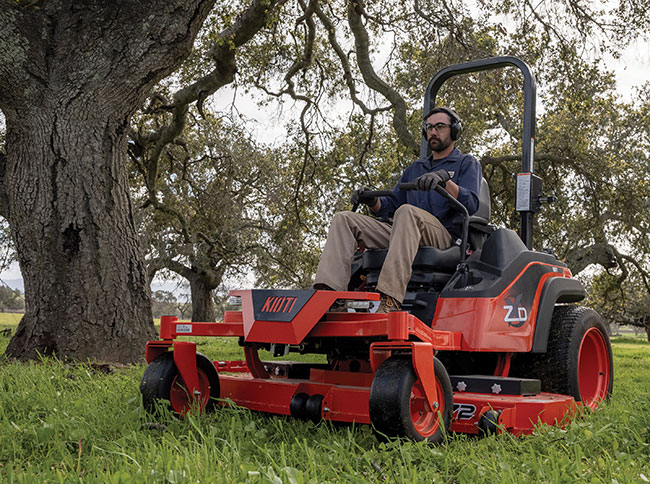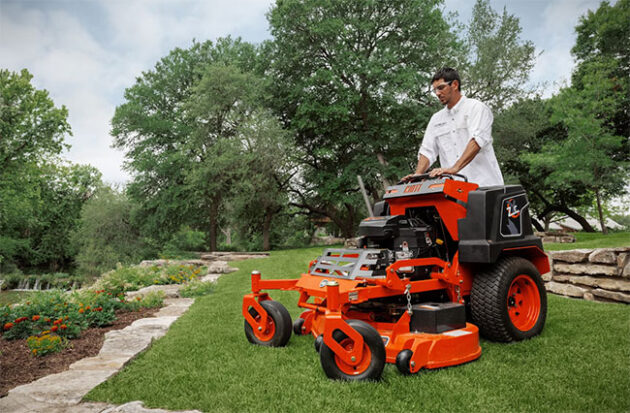
Features
Technology
Selecting a mower that fits your needs
The best mower for the job depends on the types of services offered
February 28, 2024 By Steven Benedict
 Both ride-on and stand-on mowers has their own benefits, and a job’s specific needs are apt to determine which one is best.
Photo credit: KIOTI
Both ride-on and stand-on mowers has their own benefits, and a job’s specific needs are apt to determine which one is best.
Photo credit: KIOTI Properly maintaining an outdoor space takes time, energy, grit, and a sense of personal pride in creating a functional, yet beautiful, atmosphere. But all the effort in the world can’t replace the right tools to get the job done. And when it comes to lawn care, having the right mower makes all the difference.
Before you invest in this type of machinery, it’s important to know how to select the best mower to fit your needs – a process that involves asking the right questions and assessing your requirements thoroughly. The best mower for the job depends on what types of services you offer, the size of the properties you maintain, the terrain you’re likely to encounter, and any obstacles you might face along the way.
Armed with this information, you can make a decision with confidence, knowing that the right choice will enhance your productivity and help you build your business.
Compare equipment options
Your first priority when selecting the best mower to fit your needs is performance. Essential factors to consider are deck size and mower type. Let’s take a closer look at these features.
The ideal deck size depends on the areas you plan to maintain with your mower. For example, if you will primarily be mowing large, open spaces, a wider deck will help improve efficiency. But, if you’ll need to manoeuvre in more narrow spaces, pay closer attention to the deck size.
The two primary types of mowers to consider are stand-ons and ride-ons. Each option has its own benefits, and what you choose will depend on your specific needs.
Stand-on mowers offer unique advantages. High visibility when standing allows for better manoeuvrability and control. They are smaller and fit into tighter spaces, making them ideal for lawns with numerous obstacles. The ease of getting on and off is an additional benefit, improving overall efficiency.
When mowing in lawns full of trees or greenery, you need a nimbler machine that allows you to easily hop off and on as often as needed to pick up sticks and other debris. Standing while mowing also allows your body to better absorb the impacts of rough terrain when compared to sitting.
Ride-on mowers, on the other hand, are favoured for larger projects. They’re ideal for maintaining vast, open areas that require a cutting style featuring long, straight rows. The comfort they provide, along with larger fuel tanks and wider cutting decks, makes them suitable for extended use. Ride-on mowers also offer easier maintenance with more accessible components, ensuring less downtime and enhancing overall productivity.
Consider your trailer space
As you assess equipment options, keep your trailer size in mind. Think about what else you transport on a regular basis, other than the mower, and be sure to factor in everything you need to get the job done.
For example, if your trailer is 70 inches wide, you might think a 60-inch mower is an option. But, in reality, you probably need a smaller model to be able to comfortably fit all your equipment along with the mower.

Stand-on mowers offer the advantage of high visibility and the ability to get into tighter spaces.
Invest in comfort
With mowers, comfort is about so much more than plush seats. It’s about intuitive, accessible controls, a user-friendly layout, and straightforward features that are easy to teach, ensuring you and your crew can get up to speed as quickly as possible with your new mower.
Another important consideration with mower comfort is the ergonomic design specifications. This includes not only your sitting position on the mower, but the positioning of your body and hands while operating the machine, as well as the physical force required for the controls. Adjustable controls can go a long way in enhancing the ergonomics of a mower, especially angle and height adjustment options.
Mower comfort often comes down to the manufacturer you choose. With mowing, a comfortable, efficient experience is key, and investing in an ergonomically designed mower pays dividends in the long run by reducing operator fatigue and potentially preventing accidents and/or injuries.
A note on serviceability
Before making a final decision, consider the ease of use of each mower and the overall serviceability.
Be sure to plan ahead for future turnover and training new personnel. The mower should be easy to operate to minimize training time and cut back on troubleshooting. Consider how accessible the various components are for maintenance and cleaning. Check out how to access the top of the deck. A flip-up footplate design is a key usability feature that makes servicing and cleaning easier, as well as adjusting the belt tension.
Choosing an easy-to-service machine will increase uptime. Basic service and maintenance, like checking the fluid levels before each mow, should be uncomplicated. And in case you need to check on the battery, this component should be simple to access, while still well protected from flying debris.
Time for a test drive
Now that you’ve done your research and understand how to select the best mower to fit your needs, it’s time to take a few of your top choices for a spin.
Work with your dealer to sort through the options that most closely reflect your specific needs and co-ordinate a few test runs of each. By testing a machine and seeing it in action, you’ll get a full understanding of the ergonomic design, ease of serviceability, and most importantly, the performance. After the test drives, you’ll be ready to commit to the long-term investment of the best mower for your needs.
Steven Benedict is the turf care product line manager for KIOTI Tractor, and is responsible for overseeing the expansion and advancement of KIOTI’s zero-turn mower and utility vehicle product lines.
Print this page